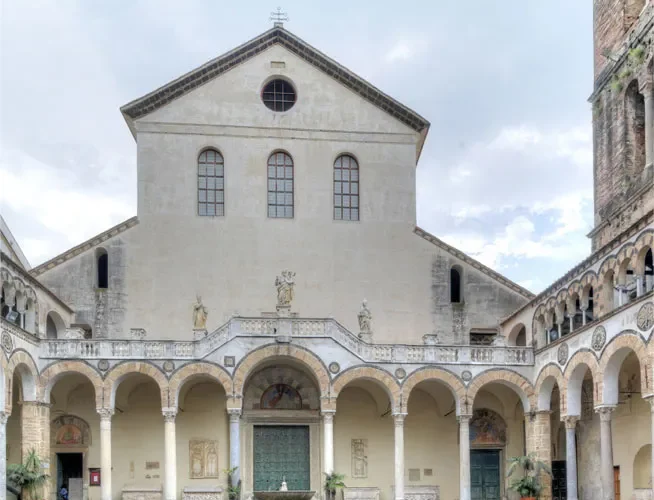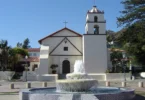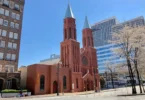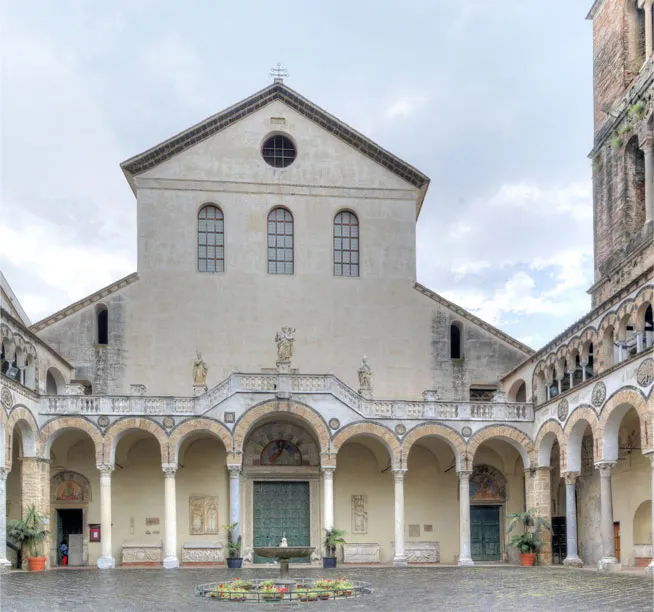
Introduction
Salerno Cathedral (or duomo) is the main church in the city of Salerno in southern Italy and a major tourist attraction. It is dedicated to Saint Matthew, whose relics are inside the crypt. The Cathedral was built when the city was the capital of the Principality of Salerno.
The Metropolitan Primatial Cathedral of St. Mary of the Angels, St. Matthew and St. Gregory VII, more commonly known as the Cathedral of Salerno, is undoubtedly the most representative place of worship in the city of Campania, standing imposingly in the heart of its historical centre. Its current structure is the result of Romanesque, Arab-Norman, Byzantine and Baroque contaminations that make it decidedly interesting from an architectural as well as a religious point of view.
History of Cathedral Church of Matthew the Apostle – Salerno
The foundation, initiated in 1076 under Robert Guiscard, in the episcopate of Alfano I, occurred simultaneously with that of the Basilica of St. Peter Alli Marmi. The Duomo was consecrated by Pope Gregory VII in 1084. In 1688, the architect Ferdinando Sanfelice remodelled the interior of the Duomo in the Neapolitan Baroque and Rococo styles. A restoration in the 1930s brought it back to an appearance similar to the original one. The Duomo is a symbol of the Italian Renaissance because inside is the tomb of Pope Gregory VII who rejected imperial domination of the church. The Duomo was damaged in World War II when, as part of the Operation Avalanche, the Allies landed in Salerno in September 1943.
The St. Matthew Cathedral founded by Roberto the Guiscard and consecrated by Pope Gregory VII, was officially opened in March 1084. The present structure dates back to the earthquake of 5 th June 1688, when it was completely rebuilt. The main entrance has been altered and the courtyard is surrounded by a covered walkway supported by twenty eight plain columns with arches and a series of Roman tombs around the walls. On the southern side of the cathedral stands the bell tower which dates back to XII century.
Saint Matthew
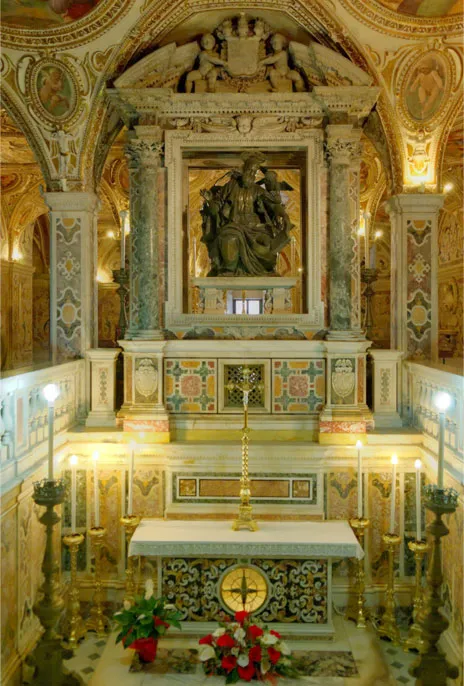
Sept. 21 marks the feast day of St. Matthew, also known as Levi, an apostle of Jesus and, according to tradition, the author of one of the four Gospels. Surprisingly little is known for certain about Matthew’s life, even though his Gospel is so crucial for the Church. The manner of Matthew’s calling by Jesus is well known — Matthew was a Jew but worked as a tax collector for the Romans in Capernaum near the Sea of Galilee, making him a pariah among his own people. When Jesus called Matthew to follow him, Matthew gave up his presumably materialistic life as a tax collector to follow the Lord.
Jesus’ calling of Matthew led some religious authorities of the Jewish community to wonder: “Why does your teacher eat with tax collectors and sinners?” To which Jesus responded: “I did not come to call the righteous but sinners.” The Catholic Encyclopedia notes, however, that no further reference is made to Matthew in the Gospels, except in the list of the Apostles, and “of Matthew’s subsequent career we have only inaccurate or legendary data.” It appears though, according to a number of other ancient sources, that he evangelized for at least a decade and a half in Asia.
Matthew’s earthly body is purported to lie in the crypt beneath the cathedral of Salerno, Italy. In the crypt, a bronze St. Matthew made by Michelangelo Naccherino in 1606 sits above the altar. The saint is shown writing the Gospel with a book resting on his left knee and a pen in his right hand. At his left side, an angel hands him an inkwell as he writes his Gospel. Alfano I, the archbishop of Salerno from 1058–1085, completed the crypt in 1081 and placed Matthew’s body in the sepulcher. The renovation in the early 17th century was carried out by architects Domenico and his son Giulio Cesare Fontana. According to legend, St. Matthew’s intercession helped to protect the city in 1544 from the dreaded pirate Ariadeno Barbarossa, supreme commander of the Turkish military fleet, when a storm that had been prayed for by devotees to St. Matthew in Salerno blew Barbarossa’s fleet away from the city. Eastern Catholics and the Orthodox churches celebrate St. Matthew on Nov. 16, along with St. Fulvianus, a prince who is recorded in some traditions as converting from paganism after Matthew’s martyrdom.
Architecture of Cathedral Church of Matthew the Apostle – Salerno
The most striking external feature is the bell tower (mid-12th century), with small arcades and mullioned windows, standing 56 m high and in Arabic-Norman style. It contains 8 large bells. The façade has a Romanesque portal with Byzantine-style bronze doors from Constantinople (1099), with 56 panels with figures, crosses and stories from Jesus’s life. The entrance has a portico with 28 antique columns whose pointed arches, with lava rock intarsia, show influence of Arab art, and contains a series of ancient Roman sarcophagi.
The interior has a nave and two aisles, divided by pilasters in which the original columns are embedded, and three apses. Artworks include two pulpits with mosaic decorations, paintings by Francesco Solimena, a 14th-century Gothic fresco of Madonna with Child and the sepulchres of the Neapolitan queen Margaret of Durazzo, of Roger Borsa and of archbishop Bartolomeo d’Arpano, and the tomb of Pope Gregory VII.
The crypt, believed to house the remains of Matthew the Apostle, is a groin vaulted hall with a basilica-like plan divided by columns. It was restored under design by Domenico Fontana and his son Giulio in 1606–1608, with marble decorations added in the 18th century. All of the ceiling frescoes are painted by Belisario Corenzio and depict scenes from the Gospel of Matthew, as well as some episodes of the history of Salerno (such as the siege of the city by the French). The Duomo Museum houses artworks from different ages, including the silver statues of the Salernitane Martyrs (13th century) and documents of the renowned Schola Medica Salernitana (the first University of Europe, according to some scholars like G. Crisci).
The cathedral through a bronze byzantine door. In the centre nave are the celebrated amboni decorated with sculptures and mosaics dating back to the last decade of the XII century. In the Treasure Chapel, one can admire the many gothic relics including St. Matthew’s arm and the statue of the Salerno Martyrs. The crypt is situated under the main alter. The crypt area is made up of nine rows of three bays with a cross shaped vault which rests on pillars. It was restored by Domenico Fontana, who designed the vault in alternate octagonal and circular sections surrounded by stuccoes and paintings. He designed the double main alter where two masses can be celebrated simultaneously.
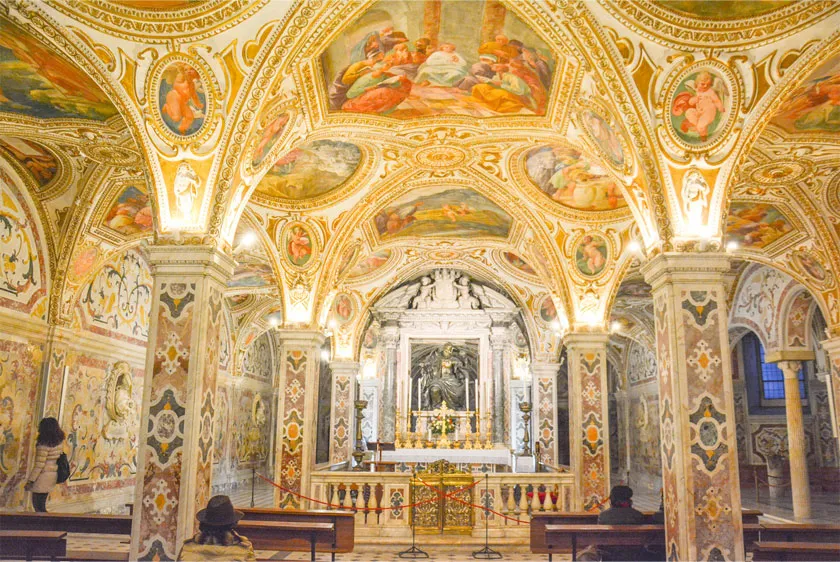
The Crypt
The crypt is one of the highlights of the Cathedral and is known for its well-preserved frescoes and unique architecture. This crypt is one of the largest in Italy and features numerous altars and tombs of saints, most notably the presence of the remains of the apostle Matthew.
The Bell Tower
The bell tower is one of the tallest structures in Salerno and offers a breathtaking view of the city and the Gulf of Salerno.
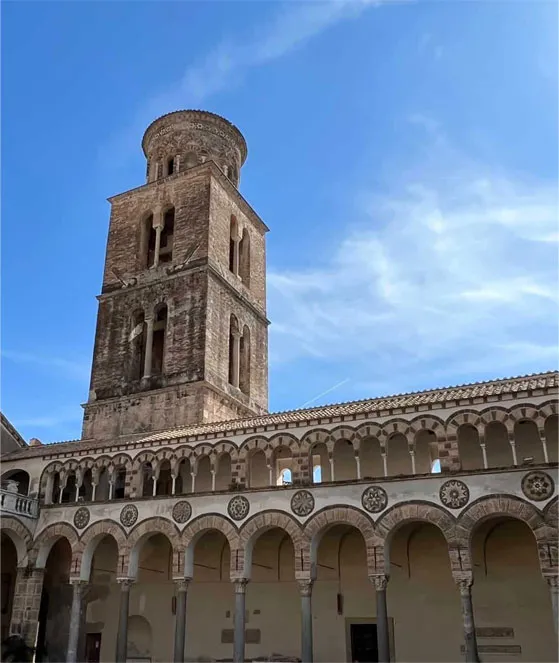
The Museum
The Cathedral of Salerno has a museum which exhibits various works of art and sacred objects related to the history of the cathedral. The museum is an excellent way to learn more about the rich history and culture of the region.
The Chapels
The Cathedral has several chapels, each with its own architectural style and artwork. The chapels are an excellent way to experience the rich history and religious culture of the region.
Feast Day
Feast Day: September 21
September 21 marks the feast day of St. Matthew
Opening Hours Cathedral
Monday 8:30 – 19:30
Tuesday 8:30 – 19:30
Wednesday 8:30 – 19:30
Thursday 8:30 – 19:30
Friday 8:30 – 19:30
Saturday 8:30 – 19:30
Sunday 10:00 – 14:00
Mass Timing
The Cathedral offers masses at different times depending on the day. During weekdays, the Holy Mass is celebrated at 7 pm at the altar of the Blessed Sacrament. On feast days, three schedules are offered: at 10 am, 12 pm and 7 pm in the Cathedral.
Contact Info
Piazza Alfano I,
84121,
Salerno,
Italy.
Phone No.
Tel : +39 089 231387
Tel : +39 89 2576778
Accommodations
Connectivities
Airway
Cathedral Church of Matthew the Apostle Salerno to Salerno Airport 24 min (23.5 km) via E45
Railway
Cathedral Church of Matthew the Apostle Salerno to Salerno Railway Station 12 min (2.7 km) via Viale Ruggero Moscati

